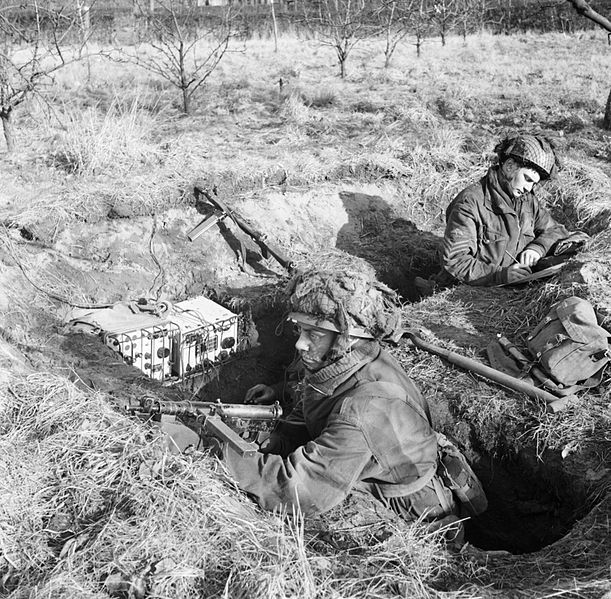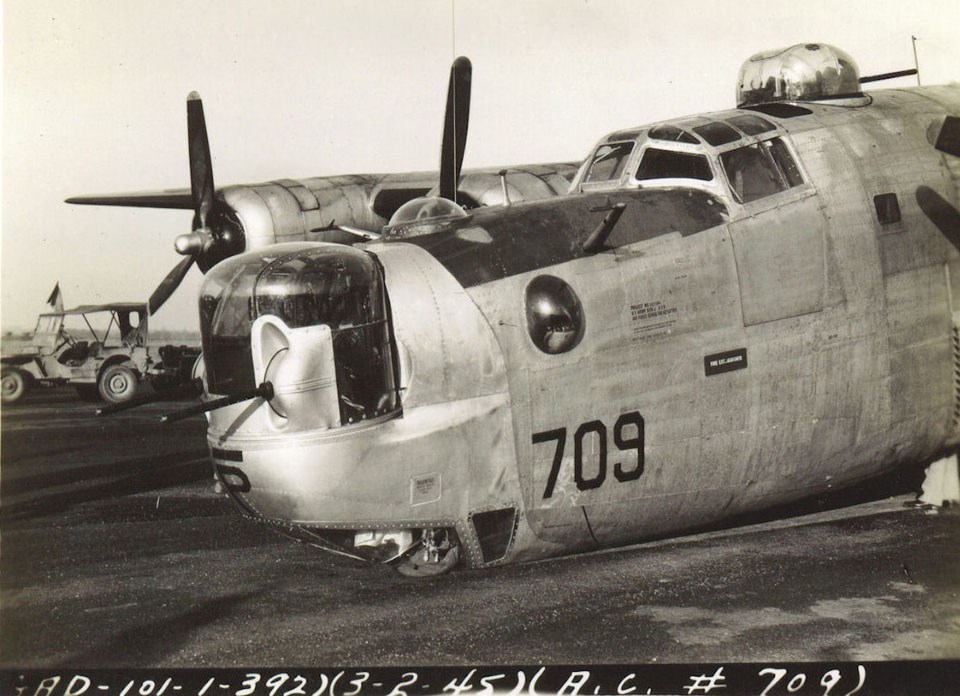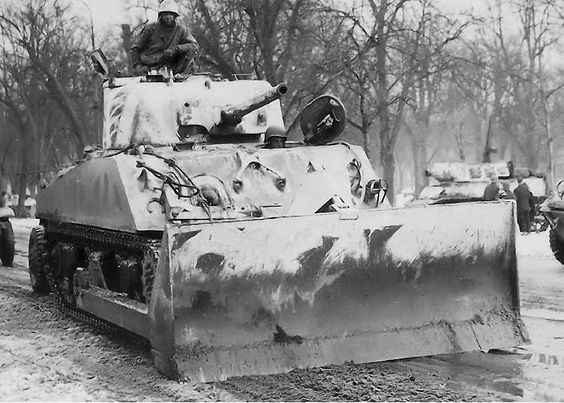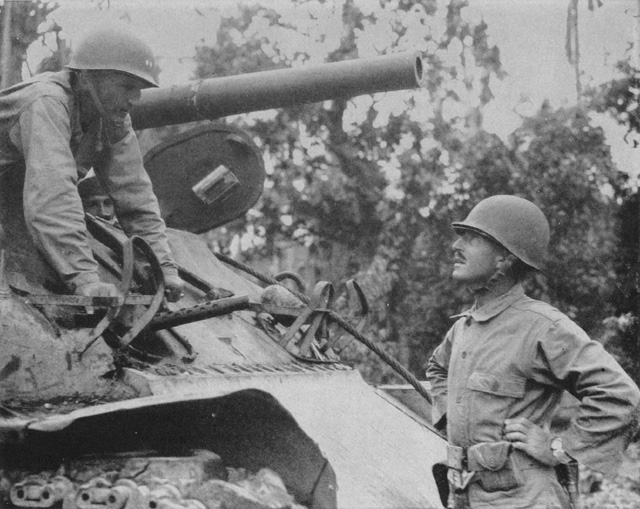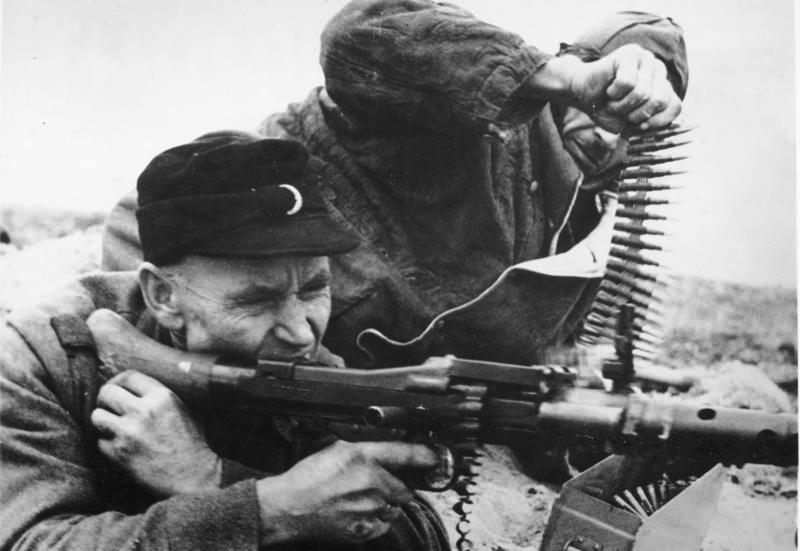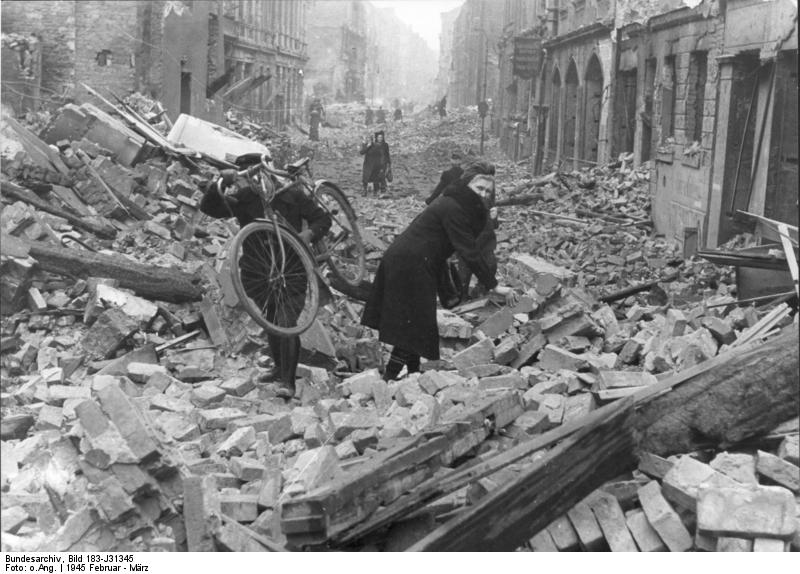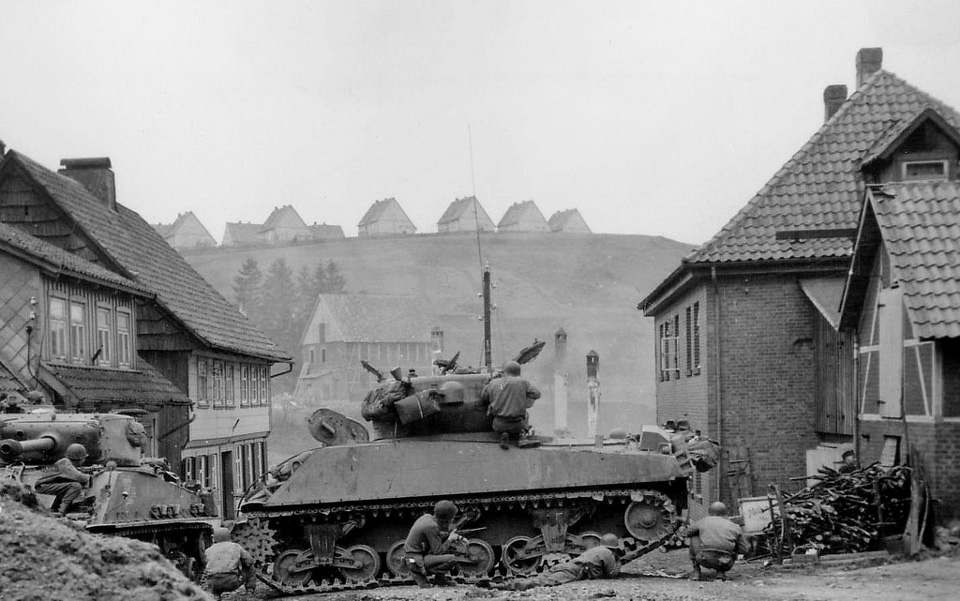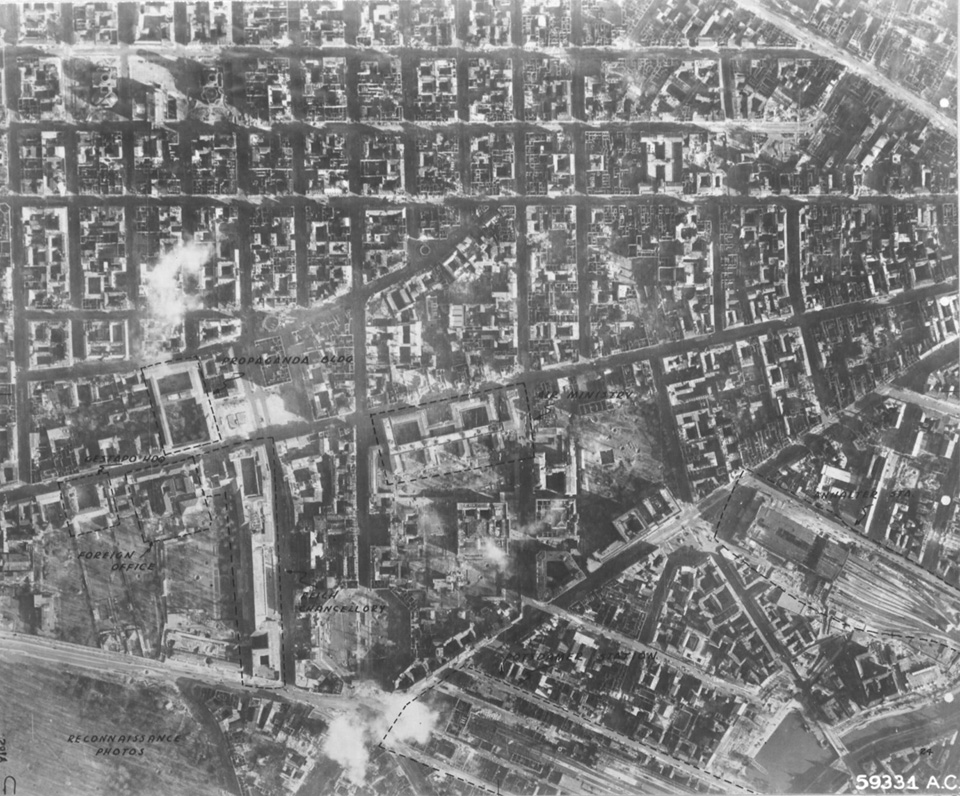Air Operations, Bonin and Volcano Islands
- 9 VII Bomber Command B-24s attack Chichi Jima.
- 10 B-24s attack Iwo Jima.
- 15 318th Fighter Group P-38s strafe Iwo Jima in two waves while escorting photo-reconnaissance aircraft over the island.
- During the night, 9 VII Bomber Command B-24s conduct snooper raids against Iwo Jima.
Air Operations, CBI
BURMA- 12 10th Air Force B-25s attack troops and supplies at Loilem.
- More than 80 10th Air Force fighter-bombers attack troops, tanks, occupied towns, and supplies at 7 locations.
- 27 fighter-bombers support Allied ground forces in the Hosi, Molo, and Myitson areas.
- Japanese Army ground forces capture the 14th Air Force airfield at Namyung.
Air Operations, Europe
1,000 B-17s, escorted by 900 fighters, raid Berlin setting fire to 5 sq km in the central districts. The Tempelhof marshalling yards and Airport are seriously damaged. About 1,000 people are killed including Judge Roland Freisler, the fanatical head of the 'People's Court'. 24 planes are lost in the raid.
RAF BOMBER COMMANDDaylight Ops:
- 36 Lancasters of No. 5 Group attack the U-boat pens at Ijmuiden (No. 9 Squadron) and Poortershaven (No. 617 Squadron) with Tallboy bombs. It is believed that these pens, in that part of Holland still occupied by the Germans, are sheltering midget submarines. The weather is clear and hits are claimed at both targets without loss.
- 1 Halifax flies an RCM sortie.
- 192 Lancasters and 18 Mosquitos of Nos. 1 and 8 Groups attack the Prosper benzol plant at Bottrop successfully.
- 8 Lancasters are lost.
- 149 Lancasters of No. 3 Group attack the Hansa benzol plant at Dortmund, but the bombing falls north and northwest of the target.
- 4 Lancasters are lost.
- 42 Mosquitos are sent to Wiesbaden and 20 to Osnabrück, 19 Halifaxes of No. 4 Group lay mines off German ports, and there are 28 Mosquito patrols and 42 RCM sorties.
- There are no losses.
GERMANY:
- 443 1st Air Division B-17s and 494 3rd Air Division B-17s attack the Tempelhof marshalling yard at Berlin.
- 116 2nd Air Division B-24s attack a synthetic-oil plant at Magdeburg (primary).
- 246 2nd Air Division B-24s attack marshalling yards at Magdepurg (targets of last resort).
- 69 heavy bombers attack various targets of opportunity.
- Extremely heavy flak over Berlin downs 23 B-17s. 2 B-24s and 8 of 844 VIII Fighter Command escorts are also lost,
- VIII Fighter Command pilots down 21 Luftwaffe aircraft over Germany between 1040 and 1245 hours.
GERMANY:
- 9th Air Division bombers attack a marshalling yard, a storage-and-repair depot, a communications center, and rail bridges at two locations.
- During the night, 18 410th Light Bomb Group A-20s attack a motor-transport depot at Mechernich (primary); 8 A-20s attack a rail junction (secondary).
Air Operations, Formosa
During the night, 63rd Heavy Bomb Squadron SB-24s attack several airfields.
[Air Operations, Philippines
- FEAF B-24s attack Aparri, Cebu City, Corregidor, the Canacao Peninsula, and Tuguegarao.
- XIII Bomber Command B-24s mount their final attack against the Cavite naval base.
- V Bomber Command B-25s and V Fighter Command P-38s attack the Daliao, Matina and Padada airfields on Mindanao.
- 3rd and 417th Light Bomb group A-20s support US Army ground forces in the Batangas area with attacks against the Lipa and Calingatan airfields on Luzon.
- Beginning at 0820 hours, two-thirds of the 11th Airborne Divisionís 511th Parachute Infantry Regiment is dropped by 48 317th Troop Carrier Group C-47s at Tagaytay Ridge, south of Manila. Due to lack of radio communication among the C-47s, the paratroopers are widely scattered, but they are able to link up with US 6th Army ground forces and seize an important road junction.
- Supported from SBDs from Marine Air Group 24 and Marine Air Group 32, which break up several Japanese Army defensive barriers, the US 1st Cavalry Division spearhead crosses the Manila city limit at 1835 hours. By 2100 hours, the cavalry troopers have liberated 3,700 American and other foreign nationals who have been interned since 1942 at Santo Tomas University.
Baltic
U-745 disappears while on patrol in the Gulf of Finland. She may have been the victim of a mine or is lost as a result of an accident from mechanical or drill failure.
| Class | Type VIIC |
| CO | Kapitänleutnant Wilhelm von Trotha |
| Location | Baltic |
| Cause | Unknown |
| Casualties | 48 |
| Survivors | None |
Battle of the Atlantic
In early February there are indications that a number of U-boats might be using the Shetlands-Faroes Channel as a transit route to the Atlantic. Escort Group 10 sails from Londonderry to patrol the area. The British frigate Bayntun gains an asdic contact (U-1279) and is unsuccessfully attacked with Hedgehog by Braithwaite and Bayntun. A single Squid firing, however, by Loch Eck brings a lot of oil and wreckage to the surface.
| Class | Type VIIC/41 |
| CO | Oberleutnant zur See Hans Falke |
| Location | NW of Shetlands |
| Cause | Squid |
| Casualties | 48 |
| Survivors | None |
CBI
BURMAThe 1st and 2nd Battalions of the 475th Infantry Regiment attack Japanese defenses at Loi-kang ridge just west of the Burma Road. Supported by artillery and air strikes, the Americans overwhelm the enemy in heavy fighting at a key position named Knight's Hill. The Japanese are cleared out at a cost of 2 killed and 15 wounded. The Mars Task Force has lost 122 killed and 938 wounded since the beginning of the operation. Japanese casualties are estimated at over 670.
[China
The Japanese capture Namyung (Nanhsiung).
[Eastern Front
In Latvia, the German troops cut off in the north, namely the 16th Army, repulse powerful attacks by the Russians in the direction of Liepaja (Libau). With help from the German navy, preparations are made for the army to be evacuated. In East Prussia there is fighting north of Heilsberg (Lidzbark Warminski), near Bartenstein, and south and north of Königsberg. German destroyers give supporting fire to their land forces, while transports take off more than 184,000 refugees.
The Vistula Army Group under Himmler is deployed in defense of northern Poland, Pomerania and Brandenburg. It contains the pressure of the 2nd Belorussian Front north of Chelmo and Sepolno and also at Küstrin (Kostrzyn), east of the Oder. Elbing is attacked from all sides, as is Pyritz (Pyrzyce), south of Stettin.
The Army Group Center is engaged near Brieg and Ohlau, at Steinau and along the whole of the middle Oder at Glogau (Glogow), Ratibor (Raciborz) and Pless (Pszczyna).
In Hungary, while fighting continues in Budapest, the German forces reach the Danube again east of Lake Velencei, east of Lake Balaton and southwest of Budapest. But the 3rd Ukraine Front, at one time cut in two, has been able to re-establish a continuous line.
ESTONIAIn the Kurland Pocket, the 2nd Baltic Front is attacking German defenses at Libau.
EAST PRUSSIAThe 2nd Guards and 31st Armies capture Landsberg and Bartenstein.
POLANDArmy Group Vistula cannot hold Soviet attacks toward the Baltic, despite the efforts of the 2nd and 11th Armies.
GERMANYAt Küstrin, The Soviet 6th Guards Army captures Ohlau and Brieg on the Oder River. To date the 1st Belorussian Front has lost 17,000 killed and 60,000 wounded, and the 1st Ukrainian Front 26,000 killed and 89,000 wounded.[MORE]
[Philippines
On Luzon the 1st Cavalry Division, US XIV Corps, reaches the outskirts of Manila and the 37th Division is also near the city. The I Corps advances south and southwest of San Jose. The XI Corps resumes its attacks against Zigzag Pass.
The battle for Manila begins, Japanese forces in the city are trapped between the 11th Airborne Division moving up from the south, XI Corps troops from the west, and units of XIV Corps from the north. The Japanese put up a ferocious defense, and the battle for the Philippines capital will go on for another month.
A squadron of the 8th Cavalry cross the bridge over the Tuliahan River just moments before the Japanese are able to destroy it. Brig-Gen William C. Chase, commander of the 1st Cavalry Brigade, leads two motorized calvary squadrons reinforced with tanks and artillery as a rescue force to enter Manila and free about 3,700 American citizens and other Allied nationals who are being held at the University of Santo Thomas. The cavalrymen surprise the enemy in a night attack and free all but 300 of the civilians who are being held hostage by Japanese troops.
In the US 8th Army sector, a parachute regiment of the 11th Airborne Division is dropped on the Tagaytay Mountains, where there are no Japanese to oppose them.
[Western Front
The American 30th and 83rd Divs and 2nd Arm Div, grouped in the XIX Corps, are added to the strength of the US 9th Army, with the 84th Div, XIII Corps, and 95th Divs as reserve formations. In the XVI Corps sector, the 35th Div completes the re-grouping of its units southeast of Maastricht, in Holland.
The 78th Div, V Corps, US 1st Army, cross the Rur and Dedenborn and takes the village. While some units of the US 7th Arm Div are attached to the 78th Div in readiness for an advance toward Schwammenauel, site of one of the biggest dams on the Rur, near Hasenfeld, units of the 9th Div take Herhahne Einrur and Berescheid, and the 2nd Div takes Bronsfeld. The divisions of the XVIII Airborne Corps continue their battle against the defenses of the Siegfried Line; units of the 1st Div enter Ramschied, which the Germans have already evacuated.
In the US 7th Army sector there is activity by patrols from the 36th Div around Drusenheim, Stainwald and Herrlisheim. On the south flank the 3 corps of the French 1st Army make further progress south and east following the fall of Colmar. The American 75th and 3rd Divs, US XXI Corps, continue to advance toward Neuf-Brisach, while the units of the French I Corps complete the first stage of the operation to liberate the south bank of the Thur River between Cernay and Ensisheim, then preparing to move north across the Thur.
[Images from February 3, 1945
|
|
|
|
|
|
|
|
